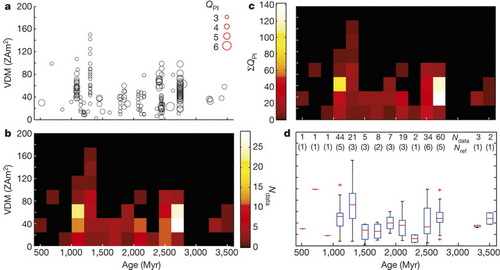


The Earth’s inner core grows by the hardening of liquid iron at its surface. The point in the Earth’s history at which this process began marks a step in the thermal evolution of the planet. Recent computational and experimental studies have presented radically differing estimates of the thermal conductivity of the Earth’s core, resulting in estimates of the timing of inner-core nucleation ranging from less than half a billion to nearly two billion years ago. Recent inner-core nucleation (high thermal conductivity) requires high outer-core temperatures in the early Earth that complicate models of thermal evolution.
The nucleation of the core leads to a different convective regime and potentially different magnetic field structures that produce an observable signal in the palaeomagnetic record and allow the date of inner-core nucleation to be estimated directly. Previous studies searching for this signature have been hampered by the paucity of palaeomagnetic intensity measurements, by the lack of an effective means of assessing their reliability, and by shorter-timescale geomagnetic variations.

Here we examine results from an expanded Precambrian database of palaeomagnetic intensity measurements selected using a new set of reliability criteria. Our analysis provides intensity-based support for the dominant dipolarity of the time-averaged Precambrian field, a crucial requirement for palaeomagnetic reconstructions of continents. We also present firm evidence for the existence of very long-term variations in geomagnetic strength. The most prominent and robust transition in the record is an increase in both average field strength and variability that is observed to occur between a billion and 1.5 billion years ago. This observation is most readily explained by the nucleation of the inner core occurring during this interval; the timing would tend to favor a modest value of core thermal conductivity and supports a simple thermal evolution model for the Earth.